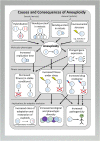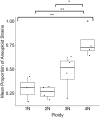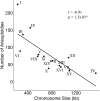Aneuploidy in yeast: Segregation error or adaptation mechanism?
- PMID: 31199875
- PMCID: PMC6772139
- DOI: 10.1002/yea.3427
Aneuploidy in yeast: Segregation error or adaptation mechanism?
Abstract
Aneuploidy is the loss or gain of chromosomes within a genome. It is often detrimental and has been associated with cell death and genetic disorders. However, aneuploidy can also be beneficial and provide a quick solution through changes in gene dosage when cells face environmental stress. Here, we review the prevalence of aneuploidy in Saccharomyces, Candida, and Cryptococcus yeasts (and their hybrid offspring) and analyse associations with chromosome size and specific stressors. We discuss how aneuploidy, a segregation error, may in fact provide a natural route for the diversification of microbes and enable important evolutionary innovations given the right ecological circumstances, such as the colonisation of new environments or the transition from commensal to pathogenic lifestyle. We also draw attention to a largely unstudied cross link between hybridisation and aneuploidy. Hybrid meiosis, involving two divergent genomes, can lead to drastically increased rates of aneuploidy in the offspring due to antirecombination and chromosomal missegregation. Because hybridisation and aneuploidy have both been shown to increase with environmental stress, we believe it important and timely to start exploring the evolutionary significance of their co-occurrence.
Keywords: adaptation; aneuploidy; environmental stress; hybridisation; yeast.
© 2019 The Authors Yeast Published by John Wiley & Sons Ltd.
Conflict of interest statement
The authors declare no conflict of interest.
Figures




Similar articles
-
Modeling the contributions of chromosome segregation errors and aneuploidy to Saccharomyces hybrid sterility.Yeast. 2018 Jan;35(1):85-98. doi: 10.1002/yea.3282. Epub 2017 Nov 12. Yeast. 2018. PMID: 28967670
-
Patterns of allele distribution in a hybrid population of the Cryptococcus neoformans species complex.Mycoses. 2020 Mar;63(3):275-283. doi: 10.1111/myc.13040. Epub 2019 Dec 9. Mycoses. 2020. PMID: 31774582
-
Cryptococcus neoformans, Unlike Candida albicans, Forms Aneuploid Clones Directly from Uninucleated Cells under Fluconazole Stress.mBio. 2018 Dec 4;9(6):e01290-18. doi: 10.1128/mBio.01290-18. mBio. 2018. PMID: 30514783 Free PMC article.
-
Consequences of Genomic Diversification Induced by Segregation Errors.Trends Genet. 2019 Apr;35(4):279-291. doi: 10.1016/j.tig.2019.01.003. Epub 2019 Feb 8. Trends Genet. 2019. PMID: 30745166 Review.
-
A Double-Edged Sword: Aneuploidy is a Prevalent Strategy in Fungal Adaptation.Genes (Basel). 2019 Oct 10;10(10):787. doi: 10.3390/genes10100787. Genes (Basel). 2019. PMID: 31658789 Free PMC article. Review.
Cited by
-
The Dynamics of Adaptation to Stress from Standing Genetic Variation and de novo Mutations.Mol Biol Evol. 2022 Nov 3;39(11):msac242. doi: 10.1093/molbev/msac242. Mol Biol Evol. 2022. PMID: 36334099 Free PMC article.
-
High throughput single-cell genome sequencing gives insights into the generation and evolution of mosaic aneuploidy in Leishmania donovani.Nucleic Acids Res. 2022 Jan 11;50(1):293-305. doi: 10.1093/nar/gkab1203. Nucleic Acids Res. 2022. PMID: 34893872 Free PMC article.
-
Recombination, admixture and genome instability shape the genomic landscape of Saccharomyces cerevisiae derived from spontaneous grape ferments.PLoS Genet. 2024 Mar 22;20(3):e1011223. doi: 10.1371/journal.pgen.1011223. eCollection 2024 Mar. PLoS Genet. 2024. PMID: 38517929 Free PMC article.
-
The Dynamic Fungal Genome: Polyploidy, Aneuploidy and Copy Number Variation in Response to Stress.Annu Rev Microbiol. 2023 Sep 15;77:341-361. doi: 10.1146/annurev-micro-041320-112443. Epub 2023 Jun 12. Annu Rev Microbiol. 2023. PMID: 37307856 Free PMC article. Review.
-
Sterol-Targeted Laboratory Evolution Allows the Isolation of Thermotolerant and Respiratory-Competent Clones of the Industrial Yeast Saccharomyces cerevisiae.Microb Biotechnol. 2025 Jan;18(1):e70092. doi: 10.1111/1751-7915.70092. Microb Biotechnol. 2025. PMID: 39853591 Free PMC article.
References
-
- Albertin, W. , Marullo, P. , Aigle, M. , Bourgais, A. , Bely, M. , Dillmann, C. , … Sicard, D. (2009). Evidence for autotetraploidy associated with reproductive isolation in Saccharomyces cerevisiae: Towards a new domesticated species. Journal of Evolutionary Biology, 22, 2157–2170. 10.1111/j.1420-9101.2009.01828.x - DOI - PubMed
-
- Bache SM, Wickham H. 2014. magrittr: A forward‐pipe operator for R. https://cran.r‐project.org/package=magrittr.
-
- Bader, O. , Schwarz, A. , Kraneveld, E. A. , Tangwattanchuleeporn, M. , Schmidt, P. , Jacobsen, M. D. , … Weig, M. (2012). Gross karyotypic and phenotypic alterations among different progenies of the Candida glabrata CBS138/ATCC2001 reference strain. PLoS ONE, 7, e52218 10.1371/journal.pone.0052218 - DOI - PMC - PubMed
Grants and funding
LinkOut - more resources
Full Text Sources
Molecular Biology Databases
